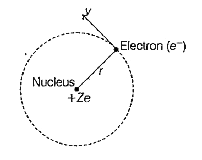State the postulates of Bohr.s theory of hydrogen atom. Derive an expression for energy of an electron in nth orbit.
Expression for Total Energy A hydrogen atom consists of a tiny positively charged nucleus (with one proton) and an electron revolving in a stable circular orbit around the nucleus.

Let e, m and v be respectively, the charge, mass and velocity of the electron and rn the radius of the orbit.
The positive charge on the nucleus is Ze, where Z is the atomic number in case of hydrogen atom, Z=1). As, the centripetal force is provided by the electrostatic force of attraction. We have,
mv2nrn=14πε0.(Ze)×er2normv2n=Ze24πε0rn ....(i)
From the second postulate, the angular momentum of the electron is
mvnrn=nh2π ....(ii)
where, n ( = 1, 2, 3, ....) is principal quantum number.
From Eqs. (i) and (ii), we get
Radius of nth orbit, rn=n2h2ε0πmZe2 .....(iii)
The energy E of an electron in an orbit is the sum of kinetic and potential energies. Using Eq. (i), kinetic energy of electron is
KE=12mv2n=Ze28πε0rn ....(iv)
The potential energy of the electron in an orbit of radius rn due to the electrostatic attraction by the nucleus is given by
PE=14πε0(Ze)(−e)rn
=−14πε0.Ze2rn ....(v)
The total energy of the electron is therefore
E=KE+PE=Ze28πε0rn−Ze24πε0rn=−Ze28πε0rn
Substituting for rn from Eq. (iii), we get
En=−mZ2e48ε20h2(1n2)
where, n= 1, 2, 3, ... . This is the expression for the energy of the electron in the nth orbit.
For hydrogen atom Z = 1, substituting the standard values, we get En=−13.6n2eV , negative energy of the electron shows that the electron is bound to the nucleus and is not free to leave it. In ground state, n=1
E1=−13.6eV
Similar Questions
State the postulates of Bohr's theory of hydrogen atom. Write the necessary equations.
View SolutionState the postulates of Bohr's theory of hydrogen atom. Write the necessary equations.
View SolutionState Bohr's postulates. Using these postulates, derive an expression for total energy of an electron in the nth orbit of an atom. What does negative of this energy signify ?
View SolutionUsing Bohr's postulates of the atomic model. Derive the expression for radius of nth electron orbit, thus obtaining the expression for Bohr's radius.
View SolutionAccording to Bohr's theory of hydrogen atom , the product of the binding energy of the electron in the nth orbit and its radius in the nth orbit
View SolutionAccording to Bohr's theory of hydrogen atom , the product of the binding energy of the electron in the nth orbit and its radius in the nth orbit
View SolutionAccording to Bohr's theory of hydrogen atom , for the electron in the nth premissible orbit
View SolutionAccording to Bohr's theory of hydrogen atom , for the electron in the nth premissible orbit
View SolutionAccording to Bohr's theory of hydrogen atom , for the electron in the nth premissible orbit
View SolutionOn the basis of Bohr.s theory, derive an expression for the radius of the nth orbit of an electron of hydrogen atom.
View Solution

